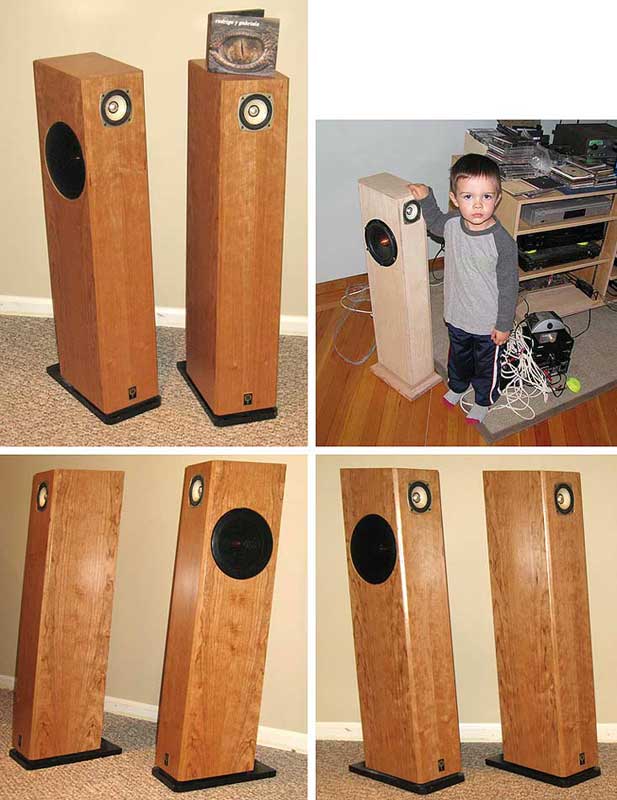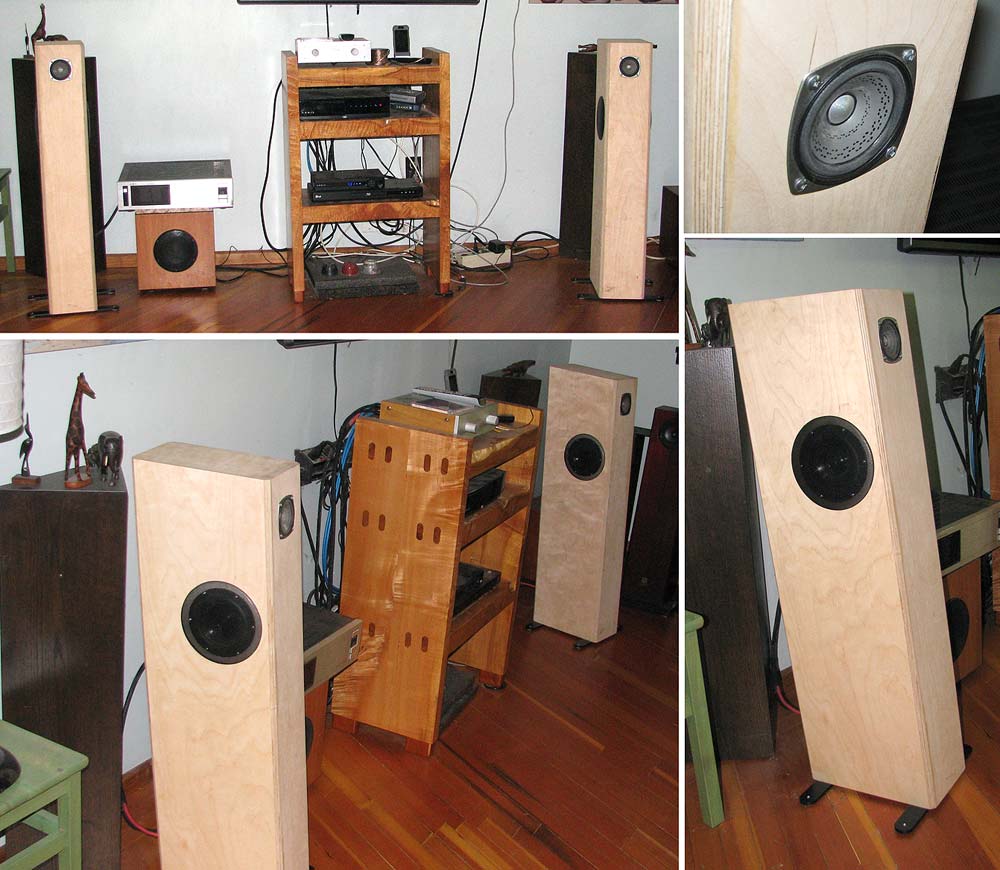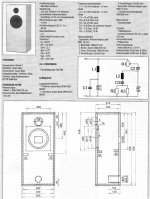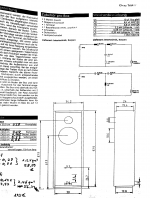Thank for all the answers. My post is comming late because i was on holidays. After few web search, i think now that the Econowave concept could be interresting for me, something around deltalite 2510/DE250 in active variant because I own a miniDSP 2x4.
It s bit more expensive but in my budget.
I will start a new thread when iw will start this project.
It s bit more expensive but in my budget.
I will start a new thread when iw will start this project.
What is yours?
Use a powered subwoofer, so you don't have to go too low with your two way.
Good to me: good (deep) bass extension, even frequency response, clear middle range not getting too up front when playing loud, nice treble making violins sound like the real thing, some "air" at top, decent sensitivity, able to play loud enought without strain, good resolution making different recordings sound different, not too demanding for the amp. Good dynamics making classical music sound alive and interesting. Wait a minute, sounds just like my speakers  .
.
Good to me: good (deep) bass extension, even frequency response, clear middle range not getting too up front when playing loud, nice treble making violins sound like the real thing, some "air" at top, decent sensitivity, able to play loud enought without strain, good resolution making different recordings sound different, not too demanding for the amp. Good dynamics making classical music sound alive and interesting. Wait a minute, sounds just like my speakers.
love that description , what speakers are those ?
How much exactly? -6dB @40HZ or lower?Good to me: good (deep) bass extension
How much is that? +-2.5dB deviation or less? Near-field, far-field or combined? In-room or anechoic chamber?even frequency response
How loud is that? Like 110dB@1m or more? Can definition of "too upfront" be defined as 3-d order harmonics exceeding 10% at this loudness?clear middle range not getting too up front when playing loud
Is this attributed to "airiness" (see below) or good tonal balance (see before) or combination of both plus phase coherence? What phase/transient response deviation value would be acceptable?nice treble making violins sound like the real thing
Isn't this attribute of smooth directivity (dispersion)? What directivity index value are you aiming at? Or lets say what deviation of normalized directivity sonogram would be acceptable within 200-20000 range? Like 30%? What minimum dispersion angle must we aim for 4kHz and 12kHz? Like 60 and 45 degrees? What about vertical dispersion regarding "on top"?some "air" at top
How much is that? Around 93dB or more?decent sensitivity
Definition on loudness - same as before?able to play loud enought without strain
How could we measure this one? Perhaps they will also on loudspeakers below "good" grade, so could we omit this?good resolution making different recordings sound different
If you mean power then it may be already solved by solving decent sensitivity, unless definition of "loud" is higher than 110dB or if SET amp is used. Or if you mean impendance variation, how much of it would fit into this description? +100%-0% of Re?not too demanding for the amp
I'd guess that this attributes to low IMD, and also amp used (amp character influence may overplay that of speaker). Should we aim for lets say IMD under 0.5% at playing loud?Good dynamics making classical music sound alive and interesting
Congratulations, man!Wait a minute, sounds just like my speakers :
Anything else to add to measurable parameters we must agree upon?
Nice driver selection btw.
PRTG: you find info in the thread, and since I have not designed the speaker myself I can´t comment further. But I am pleased, like I said, that is enough for me. Good luck with you quest for satisfying sound, we all have different taste, not to forget.
Starre, thanks for your leads. I've read your thread of Tired2way before posting my questions. It is nice work indeed!
Being just a hobbyist as well as you (and most of the members) I just wanted to set some practically measurable milestones for "goodness".
From my own experience ears are the best "first impression" judges. Nevertheless, positive brain excitement from obvious sound achievements sometimes masks some more or less serious drawbacks. So listening and liking is something like "quick win". Then it's great time to do the measurements. Just to be sure nothing is missing from the picture or that achievement isn't just coincidental cancellation of two opposite errors that can then be corrected each by itself and whole system improved even more.
So the first part of my quest is to set the measurable goals, then work towards them. Judging by listening first, measuring afterwards. And so on.
So by placing my questions I'm asking you and the community to review your own experience and define what parameters would give what type of benefits for the sound. Then to agree on set of thresholds for defined "goodness" and, probably, "excellence".
Don't you mind if I open new thread about this topic?
For Salas:
Can I use Seas CA22RNX instead of the CA22RNY? For tweeter Peerless HDS tweeter I think is not available is there a substitute for this?
The "Peerless HDS" has been replaced with a new name (but same tweeter):
ScanSpeak Discovery D2608/9130 1" Textile Dome HDS Tweeter
Salas 2way in wider enclosure
Hi,
i would like to build the Salas 2way speaker -but in an Audio Note E enclosure.
It is a little smaller in the deep- to achieve 45l.
Which crossover parts need an adjustment?
Is it possible only to lower the value of the L1 coil?
Hi,
i would like to build the Salas 2way speaker -but in an Audio Note E enclosure.
It is a little smaller in the deep- to achieve 45l.
Which crossover parts need an adjustment?
Is it possible only to lower the value of the L1 coil?
Attachments
In 40 years of building speakers the best 2-way i've done is Tysen... active XO (PLLXO @ 333Hz) SDX8 sealed, FF85KeN in midTL.

dave
Just curious, so for this setup, you use an active XO, Tysen driver as bass and FF85KeN as Mid & Trebe? Sealed?
Hi,
i would like to build the Salas 2way speaker -but in an Audio Note E enclosure.
It is a little smaller in the deep- to achieve 45l.
Which crossover parts need an adjustment?
Is it possible only to lower the value of the L1 coil?
Surely playing with L1's value is of primary concern because different baffle width will mostly change the curve in the lower mid and upper bass regions. It may be enough.
But box dimensions changing can bring smaller ripple effects higher up in frequency also. Best is to measure raw response and impedance of drivers on the new cabinet first.
When not equipped for such measurements, modeling with a diffraction simulator to mix published responses with calculated acoustic effects in a crossover simulator is recommended.
So to anticipate possible filter components value adjustments before migrating the design. Like with using those excellent software contributions from Jeff Bagby and Bill Waslo:
Jeff Bagby's Software Page
XSim free crossover designer
Just curious, so for this setup, you use an active XO, Tysen driver as bass and FF85KeN as Mid & Trebe? Sealed?
Yes. We have now developed Tysen V2 with drivers you can get. FF85wKeN + a pair of Silver Flute W14eN loaded push-push in an ML-TL. Can be biamped and we have developed a passive XO. This is our budget WAW (aka FAST)

dave
- Status
- This old topic is closed. If you want to reopen this topic, contact a moderator using the "Report Post" button.
- Home
- Loudspeakers
- Multi-Way
- The secret of building a good 2-way

